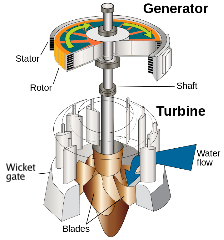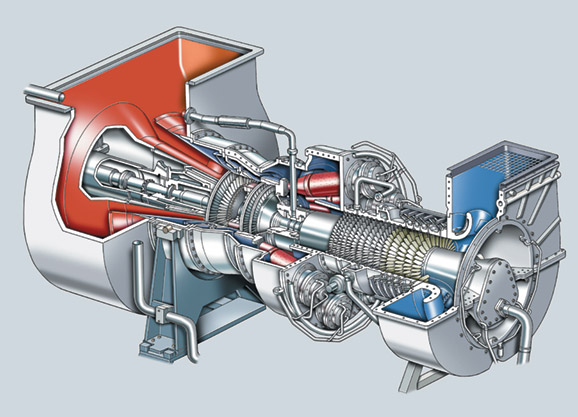Water turbines are a major source of electric power. A water turbine generally has only one rotor disk.

(from Old Moonraker at Wikipedia)
Gas turbines are used in natural gas electric power generators, jet aircraft, and a few other vehicles.
A gas turbine generally have lots of rotor disks, which can be divided into two groups: compressor rotor disks and turbine rotor disks.

(Hitachi H-25 from Russell Ray, Power Engineering)
(100-kW micro gas turbine photo from M. Cadorin et. al "Analysis of a Micro Gas Turbine Fed by Natural Gas and Synthesis Gas: MGT Test Bench and Combustor CFD Analysis")

Siemens Gas Turbine 200 (SGT-200) for industrial power generation

(from Tekla Perry: "GE’s New Gas Turbines Play Nicely With Renewables".)

(OPRA's 2 MW class OP16 gas turbine)

(natural gas or oil-powered Saturn 20 at Amherst College)
The compressor section of a gas turbine needs lots of rotor disks, because reducing the number of rotor disks reduces efficiency by either (a) increasing the pressure differential across each disk to keep the total compression ratio the same, reducing compression efficiency, or (b) keeping the pressure differential across each disk the same, reducing the total compression ratio, which reduces the efficiency of the Brayton cycle.
Water turbines don't need a compressor section.
While in principle a gas turbine could have lots of rotor disks, in practice we find that aircraft turbines generally have only 1 or 2 rotor disks, and (bolted to the ground) natural gas turbines generally have only 1 or 2 or 3 rotor disks, not that much different from water turbines which have only 1 rotor disk.
Gas turbines used in electric power generators are oil-powered or natural gas-powered electric generators and are designed to extract as much energy as possible as electric power; the thrust pushing against the bolts holding them on the ground is unnecessary.
Examples:
(Hitachi H-25 from Russell Ray, Power Engineering)
(100-kW micro gas turbine photo from M. Cadorin et. al "Analysis of a Micro Gas Turbine Fed by Natural Gas and Synthesis Gas: MGT Test Bench and Combustor CFD Analysis")
Siemens Gas Turbine 200 (SGT-200) for industrial power generation
(from Tekla Perry: "GE’s New Gas Turbines Play Nicely With Renewables".)

(OPRA's 2 MW class OP16 gas turbine)



